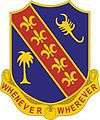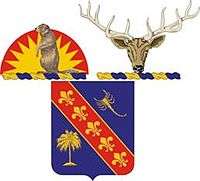148th Field Artillery Regiment
| 148th Field Artillery Regiment | |
|---|---|
|
Coat of arms | |
| Active | 1877 |
| Country |
|
| Allegiance | Idaho |
| Branch | Idaho Army National Guard, (originally). (Oregon Army National Guard (Secondary) |
| Type | Field artillery |
| Motto(s) | WHENEVER WHEREVER |
| Insignia | |
| Distinctive unit insignia |
 |
The 148th Field Artillery Regiment is a field artillery regiment of the Army National Guard.
History
World War I
The 148th Field Artillery was organized on 29 September 1917 by General Order 2, Headquarters 41st Division, trained at Camp Greene, North Carolina, Camp Mills, New York, and Camp Merritt, New Jersey. The regiment sailed from New York to France on 23 January 1918, equipped with French 155mm howitzers, tractor drawn. The 148th Field Artillery was composed of elements of the 3rd Regiment Wyoming National Guard, the 1st Separate Battalion, Colorado Field Artillery, and 1st Separate Troop, Oregon Cavalry. The regiment was organized as a part of the 66th Field Artillery Brigade, 41st Infantry Division (United States). elements of the 66th Field Artillery Brigade saw some action, and the 148th Field Artillery, armed with French 155mm howitzers, participated in the Champagne-Marne Defensive, Aisne-Marne Offensive, St. Mihiel Offensive, Meuse-Argonne Offensive, and served in the Army of Occupation in Germany.
World War Two
The unit was inducted into federal service at Coeur d’Alene as an element of the 41st Division on 16 September 1940. It arrived 23 September 1940 at Camp Murray, Washington and moved 20 March 1941 to Fort Lewis, Washington.[1] Ordered to the Pacific the regiment, less one battalion, embarked on USAT Willard A. Holbrook 22 November 1941 at the San Francisco Port of Embarkation for the Philippines.[2] With the Pensacola Convoy the regiment was diverted to Australia arriving Brisbane on 22 December where, after reloading, the Holbrook departed with the regiment on 28 December in a failed attempt to make the Philippines to reinforce forces there getting no further than Darwin where the regiment was broken up.[3][4] One battalion and the headquarters unit were ordered to defend Kupang, Timor sailing in convoy 15 February from Darwin aboard Portmar and Tulagi but had to turn back to Darwin under heavy air attack.[5][6] The convoy arrived Darwin on 18 February, the day before the port was heavily bombed and many ships lost.[7]
Lineage
Parent unit constituted 19 June 1877 as the 1st Regiment, Idaho Volunteer Militia, Territory of Idaho.
- Organized June–August 1877 from new or existing companies.
Elements in the northern territory (Lewiston and Mt. Idaho companies) withdrawn and with the addition of existing independent companies and new companies, organized 17 September 1877 as the 2nd regiment Idaho Volunteer Militia.
- 1st and 2nd Regiments Idaho Volunteer Militia disbanded 1 March 1879.
1st and 2nd Regiments reconstituted and reorganized 1889-1891 in the Idaho National Guard as the 1st Regiment to include old and new companies over the state (Companies A - F organized or reorganized 1889-1890 in the southern area; Companies G - L organized or reorganized 1891 in the northern area)
- (Organized Militia of Idaho redesignated as Idaho National Guard 14 March 1891)
1st Infantry Regiment mustered into federal service 7–18 May 1898 at Boise as the 1st Idaho Volunteer Infantry. Mustered out 25 September 1899 at the Presidio of San Francisco, California.
- Reorganized and redesignated in 1899 as the 2nd infantry (Companies reorganized over state 1899-1903).
Mustered into federal service 3–6 July at Boise Barracks for Mexican Border duty. Mustered out and reverted to state control 26 January 1917.
- called into federal service 25 March 1917; mustered in 21 September 1917
Regiment broken up, reorganized and redesignated as elements of the 41st Infantry Division as follows:
- 1st Battalion redesignated 1 October 1917 as the 146th Field Artillery Regiment (United States)
- 2nd Battalion redesignated 12 November 1917 as the 2nd Battalion, 116th Engineers
- 3rd Battalion redesignated 5 October 1917 as the 146th Machine Gun Battalion.
Elements demobilized in 1919 as follows:
- 1st Battalion, 146th Field Artillery, on 26 June 1919 at Fort D. A. Russell, Wyoming.
- 2nd Battalion, 116th Engineers, on 1 March 1919 at Camp Dix, New jersey.
- 146th Machine gun Battalion, on 3 April 1919 at Camp Funston, Kansas.
Northern elements organized in the Idaho National Guard as 1st Battalion 148th Field Artillery and federally recognized 15 March 1926 with headquarters at Coeur d'Alene assigned to the 41st Infantry Division 3 January 1930.
- Inducted into federal service 16 September 1940 at boise
1st Battalion reorganized and redesignated as the 148th Field Artillery Battalion and assigned to 41st Infantry Division, 17 July 1942 Inactivated 17 January 1946 in Japan. (205th Field Artillery Battalion consolidated with 148th Field Artillery battalion 3 July 1946)
- Reorganized and federally recognized 18 April 1947 with headquarters at Coeur d'Alene.
Ordered into active federal service 1 May 1951 at Coeur d'Alene (148th Field Artillery Battalion (NGUS) organized and federally recognized 3 August 1953 with headquarters at Lewiston) Released from active federal service and reverted to state control, 18 March 1955; concurrently, federal recognition withdrawn from 148th Field Artillery Battaloin (NGUS) Reorganized and redesignated 15 March 1956 as the 148th Armored Field Artillery Battalion.
- Reorganized and redesignated 1 July 1959 as 148th Artillery
In 1991, C Btry was withdrawn from Oregon and B Btry was assigned to Utah until with drawn in 2006. It is now entirely housed inside the state of Idaho.
Distinctive unit insignia
- Description
A Gold color metal and enamel device 1 1/16 inches (2.70 cm) in height overall consisting of a shield blazoned: Azure, on a bend Gules fimbriated Or between a scorpion bendwise and a palm tree on a mount five fleurs-de-lis, all of the like. Attached below the shield a Gold scroll inscribed “WHENEVER WHEREVER” in Red.
- Symbolism
The shield is blue to recognize the organization’s 1898 Infantry heritage. The palm tree symbolizes the service as Infantry in the Philippines and the scorpion the service as Infantry on the Mexican border. The five fleurs-de-lis on the red bend represent the five engagements as Field Artillery in France during World War I.
- Background
The distinctive unit insignia was originally approved for the 148th Field Artillery Regiment, Washington and Idaho National Guard on 20 May 1929. It was redesignated for the 148th Field Artillery Battalion on 2 March 1943. It was redesignated for the 148th Artillery Regiment, Idaho National Guard on 29 July 1960. The insignia was redesignated effective 1 September 1989, for the 148th Field Artillery Regiment, Oregon and Idaho Army National Guard and amended to revise the description and symbolism.
Coat of arms
- Blazon
- Shield: Azure, on a bend Gules fimbriated Or between a scorpion bendwise and a palm tree on a mount five fleurs-de-lis, all of the like.
- Crest: On wreaths of the colors Or and Azure, the Army National Guard crests of Oregon and Idaho in the order in which the states were admitted to the Union: OREGON: A demi-disc Gules charged with the setting sun with twelve light rays Or (the shoulder sleeve insignia of the 41st Division), behind a beaver sejant Proper. IDAHO: An elk’s head caboshed Proper.
- Motto WHENEVER WHEREVER.
- Symbolism
- Shield: The shield is blue to recognize the organization’s 1898 Infantry heritage. The palm tree symbolizes the service as Infantry in the Philippines and the scorpion the service as Infantry on the Mexican border. The five fleurs-de-lis on the red bend represent the five engagements as Field Artillery in France during World War I.
- Crest: The crests are that of the Oregon and Idaho Army National Guard.
- Background: The coat of arms was originally approved for the 148th Field Artillery Regiment, Washington and Idaho National Guard on 20 May 1929. It was redesignated for the 148th Field Artillery Battalion and amended to withdraw the crest of the Washington National Guard on 2 March 1943. It was redesignated for the 148th Artillery Regiment, Idaho National Guard on 29 July 1960. The insignia was redesignated effective 1 September 1989, for the 148th Field Artillery Regiment, Oregon and Idaho Army National Guard and amended to add the crest of the Oregon Army National Guard and revise the symbolism.
Current configuration
- 1st Battalion 148th Field Artillery Regiment (United States)
- Currently assigned to the 116th Cavalry Brigade Combat Team (CBCT) Idaho Army National Guard
- Headquarters Headquarters Battery - Pocatello, Idaho
- A Battery - Blackfoot, Idaho
- Detachment 1 Battery A - Preston, Idaho
- B Battery - Rexburg, Idaho
- Detachment 1 Battery B - St. Anthony, Idaho
- 2nd Battalion 148th Field Artillery Regiment (United States)
- 3rd Battalion 148th Field Artillery Regiment (United States)
- 4th Battalion 148th Field Artillery Regiment (United States)
Campaign credits
- War with Spain
- Manila
- Philippine Insurrection
- Manila
- Laguna de Bay
- World War I
- Champagne-Marne
- Aisne-Marne
- St. Mihiel
- Meuse-Argonne
- Champagne 1918
- World War II
- East Indies
- New Guinea (with arrowhead)
- Bismark Archipelago (with arrowhead)
- Luzon (with arrowhead)
- Leyte
- Southern Philippines (with arrowhead)
- Iraq
- Iraqi Freedom 2004-2005, IRAQI GOVERNANCE—29 JUN 2004 TO 15 DEC 2005
- Served across Iraq 2010-2011 during OPERATION NEW DAWN– 1 JAN 2009 TO 31 AUG 2011
Decorations
- Philippine Presidential Unit Citation, Streamer embroidered 17 OCTOBER 1944 to 4 July 1945
- Meritorious Unit Citation, Streamer embroidered Nov 2004 to November 2005, Iraqi Freedom III
See also
- Field Artillery Branch (United States)
- Coats of arms of U.S. Artillery Regiments
Notes
- ↑ Clay 2011, pp. 824—825.
- ↑ Matloff & Snell 1953–59, p. 72.
- ↑ Matloff & Snell 1953–59, pp. 128—129.
- ↑ Masterson 1949, p. 8.
- ↑ Matloff & Snell 1953–59, p. 129.
- ↑ Williford, Glen M. (2010). Racing the Sunrise—Reinforcing America's Pacific Outposts 1941—1942. Annapolis, Maryland: Naval Institute Press. ISBN 978-1-59114-956-9. LCCN 2010030455. Retrieved 25 June 2015.
- ↑ Gill 1957, pp. 585, 590—595.
References
- Clay, Steven E. (2011). U. S. Army Order Of Battle 1919-1941 (PDF). Volume 2. The Arms: Cavalry, Field Artillery, and Coast Artillery, 1919–41. 2. Fort Leavenworth, KS 66027: Combat Studies Institute Press. ISBN 9780984190140. LCCN 2010022326.
- Masterson, Dr. James R. (1949). U. S. Army Transportation In The Southwest Pacific Area 1941-1947. Washington, D. C.: Transportation Unit, Historical Division, Special Staff, U. S. Army.
- Matloff, Maurice; Snell, Edwin M. (1953–59). The War Department: Strategic Planning For Coalition Warfare 1941-1942. United States Army In World War II. Washington, DC: Center Of Military History, United States Army. LCCN 53061477.
 This article incorporates public domain material from the United States Army Institute of Heraldry document "148th Field Artillery".
This article incorporates public domain material from the United States Army Institute of Heraldry document "148th Field Artillery".
External links
- A History of the 66th Field Artillery Brigade
- Davis, Paul M. & Hubert K. Clay. History of Battery C, 148th Field Artillery. 1919.
